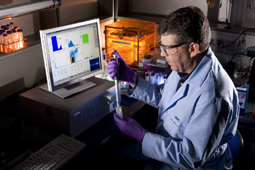NEWS RELEASES
FOR IMMEDIATE RELEASE
November 20, 2007
Fluorescence-based bioaerosol sensing project seeks to lower false alarm rates
 Sandia physicist Scott Bisson prepares samples for a flow cytometer. The cytometer, seen here sitting underneath a computer monitor, is a central element in the Enhanced Bioaerosol Detection (EBADS) program and will be integrated with an aerosol collection system to analyze potential bioaerosols on a single particle basis for detect-to-warn applications. (Photo by Randy Wong)
Sandia physicist Scott Bisson prepares samples for a flow cytometer. The cytometer, seen here sitting underneath a computer monitor, is a central element in the Enhanced Bioaerosol Detection (EBADS) program and will be integrated with an aerosol collection system to analyze potential bioaerosols on a single particle basis for detect-to-warn applications. (Photo by Randy Wong)Download 300dpi JPEG image (Media are welcome to download/publish this image with related news stories.)
LIVERMORE, CALIF. —Commercially available, fast-response bioaerosol detectors that can help guard against bioterrorist strikes in large public spaces face a significant hurdle: false alarms. Facility managers responsible for airports, train stations, sports arenas, and other venues will be loathe to install biodetection systems until they can be close to certain that the hardware won’t alarm without cause and force unnecessary evacuations.
But a Department of Homeland Security-funded project involving a group of Sandia National Laboratories researchers promises to answer the question of why false alarms occur and how to bring down the rate. The project, currently called Enhanced Bioaerosol Detection System (EBADS), aims to do just that — enhance the performance of bioaerosol detectors, specifically those based on laser-induced fluorescence (LIF).
EBADS literally takes a second look at what is in the air when a LIF sensor alarms, and determines if there is sufficient bioaerosol present for concern. If successful, EBADS could be paired with existing sensors for a more refined and commercially deployable detector system.
The project is a multilab effort involving Sandia, Lawrence Livermore, Oak Ridge, and Pacific Northwest national laboratories. Work began in 2005 as a follow-on to Sandia’s PROACT (Protective and Responsive Options for Airport Counter-Terrorism) program.
Initially, various sensors were deployed in the PROACT testbed to understand the false-alarm rate. The testbed included the LLNL Bioaerosol Mass Spectrometer (BAMS) and a selective particle collector that Sandia and Yale University assembled.
“The first phase focused on understanding the problem,” says principal investigator Tom Kulp. The Sandia EBADS team, he says, collected particles present in the air when a false alarm occurred and analyzed them in the field and in the lab.
The researchers came to the conclusion that existing sensors don’t discriminate well between biological and nonbiological particles. If that capability could be enhanced, the result might be a sensor system with significantly fewer false alarms.
The goal, says Kulp, is not to identify particles, but to determine within one to two minutes if there is an unusual amount of biological aerosol in the air — sufficient information to know you’ve got something to worry about.
This project is unique in that it seeks to develop a method, not produce a physical tool. “We are proving a methodology, which would then be implemented with the assistance of industry,” he explains.
At the end of the study phase last year, Sandia and Oak Ridge researchers determined that a staining process could be used to double-check false alarms. Kulp explains that there are two ways to do this — either by impacting and measuring the particles on a surface, or by measuring the particles in a flowing mode.
Sandia went with the flowing mode, in part because of the availability of commercial equipment. The method uses a flow cytometer, a tool widely used in lab analyses in a number of fields including molecular biology, pathology, immunology, plant biology and marine biology.
The method is fairly simple. The cytometer pulls in aerosols, which swirl through a cyclone while being immersed in a solution containing a fast-reacting stain that couples to the particles. The liquid then flows through a very fast laser zone at a rate of 5,000 particles per second where the proteins are measured. Particles with proteins light up. The system will determine there is cause for an alarm based on the distribution of fluorescence.
In the second phase of the program, the Sandia and Oak Ridge groups tested 18 blind samples from the Edgewood Chemical Biological Center. The method correctly determined with each sample whether there was cause for an alarm.
In February, the method will get a real-world road test. Aerosol to liquid collectors will be deployed alongside the existing sensor system and take in samples with each alarm, which are expected to occur about once a week. The collectors will be deployed for one month each in an office building and major U.S. subway station and airport.
The samples will be sent back to Sandia, where they will be run through the method to distinguish false alarms from true alarms. If successful, the group anticipates working with an outside partner later next year to develop a tool that employs Sandia’s methodology.Sandia is a multiprogram laboratory operated by Sandia Corporation, a Lockheed Martin company, for the U.S. Department of Energy’s National Nuclear Security Administration. With main facilities in Albuquerque, N.M., and Livermore, Calif., Sandia has major R&D responsibilities in national security, energy and environmental technologies, and economic competitiveness.
Sandia news media contact: Mike Janes, mejanes@sandia.gov, (925) 294-2447